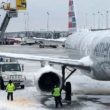By now, you know the hallmarks of the polar vortex. Ice-choked rivers and lakes. Buckets of boiling water poofing into clouds of snow. Would-be travelers stuck in airports, suffering through delays and cancellations. Indeed, airlines canceled more than half the flights into and out of Chicago’s O’Hare International and Midway International on Wednesday. Nationwide, nearly 2,600 were canceled.
Which, when you really think about it, might seem odd, because planes spend most of their lives at altitudes where temperatures sit dozens of degrees below freezing. They should be reveling in this weather, like the polar bears at the Chicago’s Brookfield Zoo and Cassie the bipedal robot.
But the problem, you see, isn’t the planes. It’s the people. “The biggest factor is the human factor,” says Jeff Kohlman of the Aviation Management Consulting Group in Colorado. You know, those people in fluorescent garb piling suitcases into cargo holds, pumping fuel, towing planes, pressurizing tires.
“When you get below 35 degrees Fahrenheit, everything starts slowing down,” Kohlman says. You may need to start deicing planes, for one thing, which starts to create delays. And while baggage handlers may be able to do their jobs wearing thick gloves, maintenance workers changing out lightbulbs and getting wrenches onto bolts must choose between warmth and dexterity. If temperatures drop to the point where it’s dangerous for workers to stay outside for very long, operations slow down even further. (Airlines have set up temporary heated shelters and doled out hot chocolate and hand warmers at O’Hare, according to the Chicago Sun Times.)
Eventually, those delays pile up into cancellations. Remember that the airline system is tightly connected, so problems at one node quickly spread. Passengers start missing their connecting flights in large numbers. Combine them with the folks in the coldest places who may stay home instead of braving the elements, and you can end up flying a half-empty plane. “It might not be the best business decision to do that,” Kohlman says. And airlines only get to make that decision if the crew makes it to the airport.
So, planes—like polar bears and robots—may not mind the cold. But airport workers—like zookeepers and roboticists—do. And they’re the folks who make them fly.
More Great WIRED Stories
- Meth, guns, pirates: The coder who became a crime boss
- Wearing Focals made me rethink smart glasses
- The need for carbon fiber could ground flying cars
- Photo essay: Science lab or art studio?
- All this newfound cynicism will hamper Big Tech
- ? Looking for the latest gadgets? Check out our picks, gift guides, and best deals all year round
- ? Want more? Sign up for our daily newsletter and never miss our latest and greatest stories
Source:WIRED










